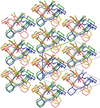issue contents
August 2022 issue

Cover illustration: The crystal structure of covellite, Cu3S(S2), is an original layered structure. Every layer is built from three sheets of S atoms with hexagonal planar coordination. In lateral sheets, every S2 atom is bound to an equivalent atom of the neighbouring layer to form an (S2)2− pair. The S1 atoms of the central sheet form tetrahedra with those of the lateral sheets. These tetrahedra are filled by Cu2 atoms (multiplicity 2), while one of every two S triangles of the central sheet is occupied by Cu1 (multiplicity one). [See Moëlo et al. (2022). Acta Cryst. B78, 627–636.]
research papers






 access
access

 access
access access
access access
access

 access
accessbook reviews


 journal menu
journal menu





































